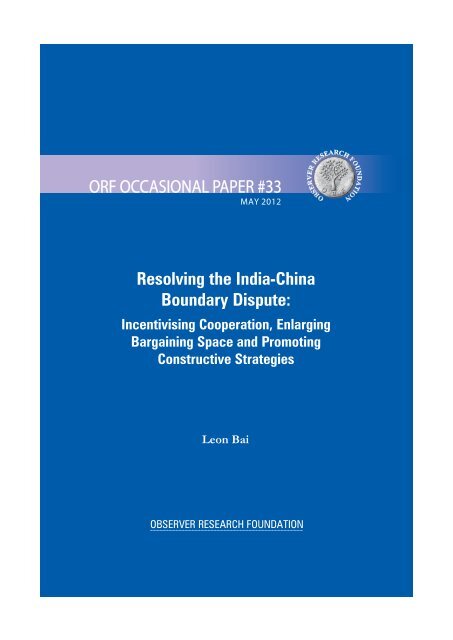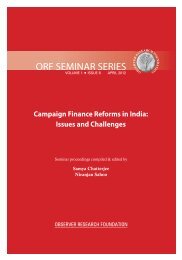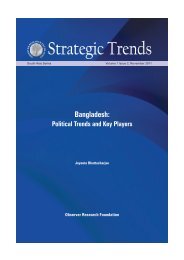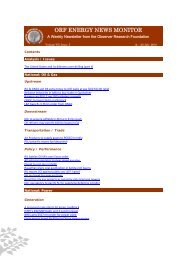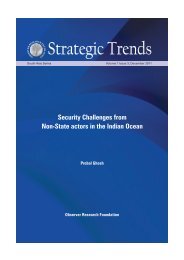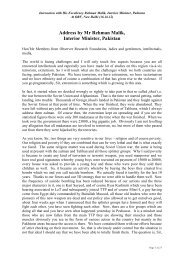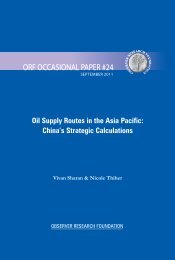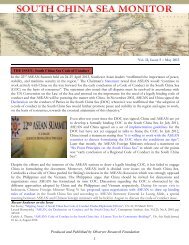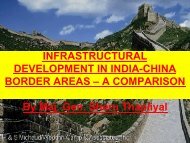Resolving the India-China Boundary Dispute - Observer Research ...
Resolving the India-China Boundary Dispute - Observer Research ...
Resolving the India-China Boundary Dispute - Observer Research ...
Create successful ePaper yourself
Turn your PDF publications into a flip-book with our unique Google optimized e-Paper software.
ORF OCCASIONAL PAPER #33<br />
MAY 2012<br />
OBSERVER RESEARCH FOUNDATION<br />
<strong>Resolving</strong> <strong>the</strong> <strong>India</strong>-<strong>China</strong><br />
<strong>Boundary</strong> <strong>Dispute</strong>:<br />
Incentivising Cooperation, Enlarging<br />
Bargaining Space and Promoting<br />
Constructive Strategies<br />
Leon Bai<br />
OBSERVER RESEARCH FOUNDATION
<strong>Resolving</strong> <strong>the</strong> <strong>India</strong>-<strong>China</strong><br />
<strong>Boundary</strong> <strong>Dispute</strong>:<br />
Incentivising Cooperation, Enlarging<br />
Bargaining Space and Promoting<br />
Constructive Strategies<br />
Leon Bai<br />
OBSERVER RESEARCH FOUNDATION
About <strong>the</strong> Author<br />
Leon Bai was an intern with <strong>the</strong> <strong>Observer</strong> <strong>Research</strong> Foundation, New<br />
Delhi in 2011. He is currently a final year undergraduate majoring in<br />
International Relations at Fudan University, <strong>China</strong>.<br />
2012 <strong>Observer</strong> <strong>Research</strong> Foundation. All rights reserved. No part of this publication may be<br />
reproduced or transmitted in any form or by any means without permission in writing from ORF.
<strong>Resolving</strong> <strong>the</strong> <strong>India</strong>-<strong>China</strong><br />
<strong>Boundary</strong> <strong>Dispute</strong>:<br />
Incentivising Cooperation, Enlarging<br />
Bargaining Space and Promoting<br />
Constructive Strategies<br />
Introduction<br />
Pessimism towards a foreseeable settlement of <strong>the</strong> <strong>India</strong>-<strong>China</strong> border<br />
1<br />
dispute is not unfounded. At <strong>the</strong> political level, <strong>the</strong>re is a “trust deficit”<br />
which impedes cooperation when both parties have sought closer<br />
2<br />
engagement with each o<strong>the</strong>r's adversary. Progress on <strong>the</strong> border issue has<br />
also come to almost a complete stop in recent years, despite <strong>the</strong> existence<br />
of multi-tiered mechanisms to facilitate resolution. Since <strong>the</strong> Agreement<br />
on <strong>the</strong> Political Parameters and Guiding Principles for <strong>the</strong> Settlement of<br />
<strong>the</strong> <strong>Boundary</strong> Question in 2005, both countries have hardly shown any<br />
interest in completing <strong>the</strong> exchange of maps detailing each party's<br />
perception of its respective Line of Actual Control (LAC). Without<br />
sufficient trust between both sides and a show of substantial progress at<br />
border talks, it is difficult to envision how an eventual resolution of <strong>the</strong><br />
border dispute could ever be achieved.<br />
However, we should not shun difficult attempts to resolve this longstanding<br />
problem. The border dispute is easily <strong>the</strong> most delicate flashpoint<br />
between <strong>India</strong> and <strong>China</strong> for a number of reasons. Both countries are<br />
already highly sensitive to activities in <strong>the</strong> disputed region and<br />
miscalculations could happen easily. The risk is compounded by <strong>the</strong> large<br />
tracts of territory in dispute, which raises <strong>the</strong> likelihood of perceived<br />
www.orfonline.org 1
ORF Occasional Paper<br />
hostility along <strong>the</strong> long border. Despite <strong>the</strong> possible high costs of a fullblown<br />
conflict, it is observed that <strong>China</strong> has not been averse to escalating<br />
territorial conflicts when it is no longer able to put up with an<br />
uncooperative neighbour; <strong>the</strong> current dispute with <strong>India</strong> should be no<br />
3<br />
exception.<br />
Even if a military confrontation is averted, putting off a settlement does<br />
have its negative consequences. From a <strong>the</strong>oretical perspective, <strong>the</strong><br />
difficulty of resolving a territorial dispute increases with time because <strong>the</strong><br />
disputed territory gets increasingly integrated into <strong>the</strong> territory of <strong>the</strong><br />
revisionist state, <strong>the</strong>re is less room for compromise when boundaries of <strong>the</strong><br />
disputed area become less flexible and more precise, and <strong>the</strong> disputed area<br />
holds increasing symbolic value to disputant states and thus cannot be<br />
4<br />
traded away easily. In <strong>the</strong> instance of <strong>India</strong> and <strong>China</strong>, <strong>the</strong>re are similar<br />
signs of entrenchment taking place. After <strong>the</strong> border war in 1962, <strong>the</strong><br />
<strong>India</strong>n Parliament unanimously passed a resolution stating that “<strong>India</strong> will<br />
5<br />
recover each inch of territory lost to <strong>the</strong> Chinese” ; in 1984, <strong>the</strong> Chinese<br />
initiated claims to Tawang, on <strong>the</strong> grounds that it was <strong>the</strong> birthplace of <strong>the</strong><br />
th 6<br />
6 Dalai Lama and thus “central to Tibetan Buddhism”. Postponing <strong>the</strong><br />
search for an eventual settlement would ei<strong>the</strong>r entail <strong>the</strong> risk of escalation<br />
or make <strong>the</strong> dispute more intractable in <strong>the</strong> future.<br />
Nei<strong>the</strong>r should <strong>India</strong> nor <strong>China</strong> contemplate <strong>the</strong> use of force to reach a<br />
resolution. A settlement that has been unilaterally imposed by one party on<br />
<strong>the</strong> o<strong>the</strong>r cannot be expected to satisfy <strong>the</strong> interests of stakeholders and<br />
would be susceptible to being overturned in <strong>the</strong> future. The costs of<br />
employing force are also patently immense at many levels-<strong>the</strong> immediate<br />
economic costs and huge loss of lives, a bankruptcy of trust between <strong>the</strong>se<br />
two powers and a protracted period of instability in <strong>the</strong> region, to name a<br />
few.<br />
2<br />
www.orfonline.org
<strong>Resolving</strong> <strong>the</strong> <strong>India</strong>-<strong>China</strong> <strong>Boundary</strong> <strong>Dispute</strong><br />
This paper, <strong>the</strong>refore, explores how a peaceful settlement of <strong>the</strong> <strong>India</strong>-<br />
<strong>China</strong> border dispute can be engendered. It sees <strong>the</strong> path to resolution as a<br />
three-step process and identifies <strong>the</strong> obstacles at each stage.<br />
Recommendations are <strong>the</strong>n made to address <strong>the</strong>se challenges. It is argued<br />
that to whet <strong>China</strong>'s appetite for cooperation, <strong>India</strong> must work towards<br />
maintaining its power position relative to <strong>China</strong> and seize <strong>the</strong> opportunities<br />
in <strong>the</strong> post-Dalai Lama era. With <strong>the</strong> intent to cooperate, <strong>the</strong>se two<br />
countries must enlarge <strong>the</strong> room for cooperation by managing public<br />
opinion, acting with resolve and acknowledging each side's ownership of<br />
certain contested territories and a common LAC. Obstructive strategies<br />
such as disguising one's positions as principles and an aggressive extension<br />
of claims should also be promptly discerned and countered.<br />
Review of Existing Literature<br />
Existing <strong>the</strong>ories of conflict resolution have offered clues as to how<br />
territorial disputes can be amicably resolved. Scholars have located<br />
contributing factors at three levels–<strong>the</strong> inter-state level, <strong>the</strong> unit (state) level<br />
and <strong>the</strong> intra-state level. Between states, <strong>the</strong> distribution of power can<br />
influence state behaviour in conflict resolution. One state may seek to end<br />
<strong>the</strong> dispute peacefully so as to befriend a neighbour to balance ano<strong>the</strong>r<br />
7<br />
opposing state. Also, a somewhat asymmetrical distribution of power in<br />
favour of <strong>the</strong> status quo (but not too asymmetrical) is likely to produce<br />
inter-state cooperation: Severe asymmetry brings about a unilateral<br />
solution that is unlikely to please all parties, but a relatively weaker<br />
revisionist state acknowledging <strong>the</strong> status quo party's position of<br />
superiority is more amenable to peaceful propositions put forth by <strong>the</strong><br />
8<br />
latter.<br />
www.orfonline.org 3
ORF Occasional Paper<br />
Characteristics of <strong>the</strong> state and state interests have significant implications<br />
on <strong>the</strong> outcome of territorial disputes as well. Democracies face greater<br />
resistance when employing violence and are thus discouraged from doing<br />
so; however, it should be noted that even in democracies <strong>the</strong> ease of<br />
reaching a feasible solution varies with <strong>the</strong> quotient requirements for<br />
9<br />
agreements to be ratified by <strong>the</strong> legislature. It is also possible that similar<br />
political regimes share similar norms and rules that facilitate negotiations:<br />
disputants are saved from having to debate over differing norms that often<br />
10<br />
cannot be compromised. As rational actors, states also advance <strong>the</strong>ir<br />
interests in resolving territorial disputes. Reasons for cooperation are as<br />
many as <strong>the</strong> forms of state interests. From an economic perspective, stable<br />
borders can simply bring greater monetary gains due to ease of cross-<br />
11<br />
border trade. Or, <strong>the</strong> status quo party might expect benefits in <strong>the</strong> long run<br />
for making concessions to improve ties.<br />
Bearing security considerations, a state beset by regime insecurity is<br />
12<br />
expected to be more cooperative to trade for assistance from neighbours.<br />
Maintaining a reputation for “toughness” in territorial disputes is also an<br />
economical means to ward off potential challengers. Finally, salience of <strong>the</strong><br />
disputed land, which could range from possessing material resources to its<br />
psychological value, can be indicative of <strong>the</strong> extent of competition that <strong>the</strong><br />
disputant states will be engaged in; never<strong>the</strong>less <strong>the</strong> fact that <strong>the</strong> escalation<br />
or de-escalation of territorial conflict with salience of disputed land<br />
remaining unchanged points to little correlation between <strong>the</strong>se two<br />
13<br />
variables.<br />
Domestic actors impacting resolution outcomes consist of political<br />
leaders, negotiators and <strong>the</strong> public. The amount of time in political office<br />
and <strong>the</strong> reputation of political leaders can determine whe<strong>the</strong>r <strong>the</strong>se leaders<br />
14<br />
would undertake peaceful pursuits. The importance of leadership is also<br />
4<br />
www.orfonline.org
<strong>Resolving</strong> <strong>the</strong> <strong>India</strong>-<strong>China</strong> <strong>Boundary</strong> <strong>Dispute</strong><br />
underscored by <strong>the</strong> fact that political resolve, readiness to accept<br />
15<br />
compromise and even preferences facilitate nonviolent settlement.<br />
Sometimes a way out is only possible when negotiators do not adopt<br />
16<br />
disruptive bargaining strategies. The public is also a significant actor for it<br />
sets constraints on what an acceptable negotiation outcome would be,<br />
17<br />
especially in democracies.<br />
Ideational and perceptual elements permeate <strong>the</strong> three above mentioned<br />
levels and deserve mention. At <strong>the</strong> inter-state level <strong>the</strong> revisionist state that<br />
perceives itself matching its opponent in power is encouraged to employ<br />
violent means to achieve territorial aims. At <strong>the</strong> unit level states may<br />
sometimes act against what is good to attain what is right; <strong>the</strong>y might also<br />
be informed by particular norms and historical memories entrenched<br />
through time. Within <strong>the</strong> state <strong>the</strong> public might have also attached<br />
psychological or symbolic value to <strong>the</strong> disputed territory that makes <strong>the</strong><br />
conflict more intractable.<br />
However, <strong>the</strong> plethora of identified factors is symptomatic of <strong>the</strong><br />
limitations in current research. It suggests a lack of consensus among<br />
scholars on <strong>the</strong> relative importance of <strong>the</strong>se variables, which understandably<br />
rests upon <strong>the</strong> states in question–for example certain states are<br />
more capable of subjugating norms and principles to national interests.<br />
Hence, in <strong>the</strong> context of this paper, instead of analysing it with a one-sizefits-all<br />
framework inflated by multifarious variables, it would be more<br />
expedient for our research if significant variables can be identified, based<br />
on an understanding of <strong>India</strong> and <strong>China</strong>'s behaviour, interests and<br />
domestic circumstances, and integrated into a more parsimonious<br />
structure.<br />
www.orfonline.org 5
ORF Occasional Paper<br />
Moreover, in formulating a general <strong>the</strong>ory of territorial dispute resolution,<br />
scholars have tended towards identifying contributing factors ra<strong>the</strong>r than<br />
causal factors because <strong>the</strong> former, dealing with questions of probabilities<br />
ra<strong>the</strong>r certainties (e.g. it is more probable that conflicts can be resolved<br />
peacefully between democracies), lends itself to generalisations. It falls<br />
short of explaining how and why a specific conflict is going to be resolved.<br />
This inadequacy can only be overcome by grounding our analysis in <strong>the</strong><br />
substance of <strong>the</strong> territorial dispute.<br />
Constructing a Theoretical Framework<br />
Any <strong>the</strong>ory of conflict resolution should endeavour to illuminate <strong>the</strong> path<br />
to peaceful settlement. To this end a three-part <strong>the</strong>oretical framework,<br />
18 19<br />
inspired by <strong>the</strong> works of Fravel and Kacowicz, is conceived as follows:<br />
(1) Motivations for Change from Delaying to Cooperative Strategy:<br />
States must have incentives to switch from a delaying strategy, in<br />
which states maintain <strong>the</strong>ir respective territorial claims and do not<br />
attempt to modify <strong>the</strong> status quo, to a cooperative strategy whereby<br />
20<br />
an offer to ei<strong>the</strong>r exchange territory or relinquish claims is made.<br />
Incentives would only be effective in motivating change if <strong>the</strong>y<br />
coincide with state interests and are powerful enough to offset <strong>the</strong><br />
costs. Being rational actors, states pursue <strong>the</strong>ir own interests and<br />
engage in cost-benefit calculations. They must <strong>the</strong>refore be<br />
persuaded that <strong>the</strong>y would be compensated for giving up advantages<br />
associated with non-action, like buying time for a streng<strong>the</strong>ned<br />
21<br />
bargaining position in <strong>the</strong> future.<br />
(2) Size of Bargaining Space: States willing to cooperate on <strong>the</strong> dispute<br />
must <strong>the</strong>n contemplate <strong>the</strong> size of <strong>the</strong>ir respective bargaining space,<br />
6<br />
www.orfonline.org
<strong>Resolving</strong> <strong>the</strong> <strong>India</strong>-<strong>China</strong> <strong>Boundary</strong> <strong>Dispute</strong><br />
which is <strong>the</strong> extent of cooperation permissible by <strong>the</strong> state and <strong>the</strong><br />
22<br />
intra-state actors. Bargaining space can ei<strong>the</strong>r be constricted or<br />
enlarged at both levels: for instance, <strong>the</strong> salience of <strong>the</strong> disputed land<br />
may have diminished over <strong>the</strong> years, giving <strong>the</strong> state larger bargaining<br />
space; on <strong>the</strong> o<strong>the</strong>r hand, <strong>the</strong> public may rebuff concessions that are<br />
perceived to be too high a price for peaceful resolution. In short, <strong>the</strong><br />
state and <strong>the</strong> domestic actors hold certain interests, preferences and<br />
perceptions that may limit <strong>the</strong> range of acceptable concessions and<br />
compromises <strong>the</strong> state can make.<br />
(3) Bargaining Strategies: After an appraisal of <strong>the</strong> bargaining chips at<br />
hand, disputant states engage each o<strong>the</strong>r through <strong>the</strong>ir preferred<br />
bargaining strategies at <strong>the</strong> negotiation table. From <strong>the</strong> perspective of<br />
achieving successful outcomes, bargaining strategies can be ei<strong>the</strong>r<br />
constructive or obstructive. A state keen to see <strong>the</strong> actualisation of<br />
peaceful settlement might initiate reciprocal offers to expedite <strong>the</strong><br />
process; ano<strong>the</strong>r state that is more eager to extract maximum gains at<br />
<strong>the</strong> lowest cost possible might employ linkage tactics which <strong>the</strong> o<strong>the</strong>r<br />
23<br />
party would find difficult to accept. The choice of bargaining<br />
strategies depends on a range of factors which include past success in<br />
employing similar strategies, stakes and interests in <strong>the</strong> dispute as well<br />
as established preferences.<br />
The proposed framework is highly useful in pointing a way out for <strong>the</strong><br />
<strong>India</strong>-<strong>China</strong> border dispute. It is capable of demonstrating <strong>the</strong> relative<br />
importance of each factor by emphasising motivations for change as <strong>the</strong><br />
primary driver of <strong>the</strong> settlement process, followed by bargaining space and<br />
bargaining strategies impacting <strong>the</strong> process at <strong>the</strong> later stages. This is not to<br />
say that <strong>the</strong>ir effects are inconsequential; bargaining space can be<br />
constricted to <strong>the</strong> extent that any form of concession is realistically<br />
www.orfonline.org 7
ORF Occasional Paper<br />
impossible and an aggressive bargaining strategy can be so exacting on <strong>the</strong><br />
recipient party that it would ra<strong>the</strong>r exit negotiations than to compromise.<br />
In addition, this framework is able to accommodate context-specific<br />
variables that are relevant to <strong>the</strong> peaceful resolution of <strong>the</strong> dispute. It<br />
examines <strong>the</strong> salient elements of <strong>the</strong> dispute and <strong>the</strong> disputant states and<br />
sorts <strong>the</strong>m according to how <strong>the</strong>y would impact <strong>the</strong> resolution process.<br />
Therefore, in resolving <strong>the</strong> border issue between <strong>India</strong> and <strong>China</strong>, it<br />
supersedes o<strong>the</strong>r general <strong>the</strong>ories by considering, assessing and offering<br />
specifics.<br />
A Brief Introduction of <strong>the</strong> Border <strong>Dispute</strong><br />
The contested areas between <strong>India</strong> and <strong>China</strong> now consist of two sectors.<br />
The Western Sector refers to <strong>the</strong> Aksai Chin region between <strong>the</strong><br />
Karakoram Range and <strong>the</strong> Kunlun Range. <strong>India</strong> claims that its border<br />
should begin from <strong>the</strong> Karakoram Pass and run along <strong>the</strong> Kunlun Range;<br />
<strong>the</strong> Chinese government asserts that <strong>the</strong> boundary should be along <strong>the</strong><br />
Karakoram Range, where <strong>the</strong> LAC now lies. The Eastern Sector<br />
encompasses <strong>the</strong> <strong>India</strong>n state of Arunachal Pradesh whose nor<strong>the</strong>rn<br />
border coincides with <strong>the</strong> McMahon Line. Chinese claims in this sector<br />
have varied from parts of Arunachal Pradesh to <strong>the</strong> entire state. On <strong>the</strong><br />
o<strong>the</strong>r hand, <strong>the</strong> dispute over <strong>the</strong> Middle Sector, where Sikkim lies, appears<br />
to have dissipated as <strong>China</strong> formally ceded its claim to Sikkim by referring<br />
to it as <strong>the</strong> “Sikkim State of <strong>the</strong> Republic of <strong>India</strong>” in <strong>the</strong> 2005 Joint<br />
24<br />
Statement with <strong>India</strong>.<br />
Conflicting claims have arisen mainly from <strong>the</strong> lack of any formal treaty<br />
defining <strong>the</strong> boundaries and varying interpretations of border agreements.<br />
In <strong>the</strong> Western Sector, efforts by <strong>the</strong> British to delimit <strong>the</strong> boundary in<br />
8<br />
www.orfonline.org
<strong>Resolving</strong> <strong>the</strong> <strong>India</strong>-<strong>China</strong> <strong>Boundary</strong> <strong>Dispute</strong><br />
several occasions since <strong>the</strong> 1840s were hindered time and again by <strong>the</strong> lack<br />
of response from <strong>the</strong> Chinese; this eventually led to an “undefined” border<br />
between <strong>India</strong> and <strong>China</strong> when <strong>the</strong> British left <strong>India</strong>.<br />
In <strong>the</strong> Middle Sector, <strong>the</strong> border between Sikkim, <strong>the</strong>n a protectorate of<br />
<strong>India</strong>, and Tibet was demarcated in 1895. As such, when Sikkim became an<br />
<strong>India</strong>n state, its border with <strong>China</strong> would also become <strong>India</strong>'s. <strong>China</strong><br />
contested <strong>the</strong> legality of this merger on <strong>the</strong> basis of Sikkim's historical<br />
affiliation with Tibet. In <strong>the</strong> Eastern Sector, <strong>India</strong> and <strong>China</strong>'s claims stem<br />
from different perceptions of <strong>the</strong> Simla Accord in 1914 which saw Tibet<br />
defining its border with <strong>India</strong> according to <strong>the</strong> McMahon Line. <strong>China</strong><br />
refused to recognise this agreement, claiming that Tibet was under its<br />
suzerainty and hence was not in a capacity to enact agreements with o<strong>the</strong>r<br />
nations; fur<strong>the</strong>rmore even though <strong>China</strong> participated in <strong>the</strong> negotiations it<br />
was not a signatory, meaning that <strong>China</strong> did not acknowledge <strong>the</strong><br />
McMahon Line.<br />
It was <strong>the</strong> difference in interpretations that provoked <strong>the</strong> border war in<br />
1962 which would in turn alter <strong>the</strong> strength of claims made by both states.<br />
Prior to <strong>the</strong> war attempts to open negotiations on <strong>the</strong> border issue failed<br />
and border incidents continued. They were left to escalate, with <strong>the</strong> Chinese<br />
believing that <strong>India</strong> must be deterred from making future incursions and<br />
punished for perceived subversion in Tibet, and <strong>India</strong>'s misplaced<br />
confidence that a war was unlikely to happen. A war eventually broke out in<br />
both <strong>the</strong> western and eastern sectors. An important consequence of <strong>the</strong><br />
war on <strong>the</strong> territorial claims was that <strong>China</strong> gained de facto control of <strong>the</strong><br />
disputed Aksai Chin.<br />
There was no concrete progress in border talks until <strong>the</strong> 1990s. In 1993,<br />
both countries signed <strong>the</strong> Agreement on Maintenance of Peace and<br />
www.orfonline.org 9
ORF Occasional Paper<br />
Tranquillity along <strong>the</strong> LAC, followed by <strong>the</strong> Agreement on Confidence<br />
Building Measures in <strong>the</strong> Military Field along <strong>the</strong> LAC in 1996. The latest<br />
agreement to be signed was <strong>the</strong> Agreement on <strong>the</strong> Political Parameters and<br />
Guiding Principles for <strong>the</strong> Settlement of <strong>the</strong> <strong>Boundary</strong> Question in 2005.<br />
This agreement is significant from <strong>India</strong>'s point of view as Article VII<br />
states that, "In reaching a boundary settlement, <strong>the</strong> two sides shall<br />
safeguard <strong>the</strong> interests of <strong>the</strong>ir settled populations in <strong>the</strong> border areas".<br />
During this period <strong>the</strong>re was also a maturation of dialogue mechanisms. A<br />
Joint Working Group (JWG) was set up in 1988 to replace <strong>the</strong> annual<br />
dialogue of Vice Ministers and it consisted of bureaucrats and experts that<br />
are well-suited to engage in technical discussions on <strong>the</strong> border issue. In<br />
2003, Special Representatives were also appointed with <strong>the</strong> political<br />
mandate to steer negotiations.<br />
However, as a reflection of <strong>the</strong> lukewarm diplomatic ties in recent years,<br />
<strong>India</strong> and <strong>China</strong> became increasingly confrontational over <strong>the</strong> boundary<br />
issue. In 2006, just before Chinese President Hu Jintao's visit to <strong>India</strong>, <strong>the</strong><br />
Chinese ambassador claimed on <strong>India</strong>'s national television that <strong>the</strong> entire<br />
Arunachal Pradesh belonged to <strong>China</strong>.<br />
A year later, it was widely publicised that an <strong>India</strong>n official from Arunachal<br />
Pradesh was denied a visa to visit <strong>China</strong>; <strong>India</strong> promptly retaliated by<br />
inviting <strong>the</strong>n Taiwanese presidential candidate Ma Yingjeou to visit <strong>India</strong>.<br />
An increase in <strong>the</strong> number of territorial transgressions was also observed.<br />
What might have been preposterous, from <strong>India</strong>'s perspective, was <strong>China</strong>'s<br />
opposition to <strong>the</strong> <strong>India</strong>n Prime Minister's trip to Arunachal Pradesh during<br />
his election campaign in 2009; <strong>India</strong> protested by being conspicuously<br />
silent on <strong>the</strong> one-<strong>China</strong> policy in its Joint Statement with <strong>China</strong> during<br />
Chinese Premier Wen Jiabao's visit to <strong>India</strong> in 2010.<br />
10<br />
www.orfonline.org
<strong>Resolving</strong> <strong>the</strong> <strong>India</strong>-<strong>China</strong> <strong>Boundary</strong> <strong>Dispute</strong><br />
Investigating Motivations for Change<br />
In seeking a resolution to <strong>the</strong> border dispute, <strong>India</strong> has shown greater<br />
urgency than <strong>China</strong>, which insists that <strong>the</strong> intractable issue should be<br />
sidestepped for now to avoid crippling development in o<strong>the</strong>r bilateral<br />
issues. In fact, <strong>China</strong> is reluctant to seek a resolution as a delaying strategy<br />
could bestow it with a streng<strong>the</strong>ned bargaining position on <strong>the</strong> border<br />
issue. Jump-starting <strong>the</strong> settlement process is <strong>the</strong>refore only likely to occur<br />
when <strong>China</strong> favours cooperation over non-action, possibly under<br />
conditions of regime insecurity.<br />
As argued by Fravel, <strong>China</strong> has shown greater readiness to cooperate and<br />
25<br />
compromise when it experiences regime insecurity. Regime insecurity has<br />
both domestic and foreign origins. A state may face internal threats to its<br />
territorial integrity and political stability. It can choose to cooperate with<br />
o<strong>the</strong>r disputant states that will in return provide support to neutralise <strong>the</strong><br />
internal threats or diplomatic recognition that shores up <strong>the</strong> legitimacy of<br />
<strong>the</strong> incumbent regime. It may also face external threats to its regime, in <strong>the</strong><br />
form of challenges to its standing in <strong>the</strong> international system or<br />
competition with an adversary.<br />
The state is enticed to compromise in territorial disputes to win allies for<br />
external balancing, or to gain access to resources for internal balancing. In<br />
<strong>the</strong> instance of <strong>China</strong>, it is observed that regime insecurity is always<br />
followed by an increase in agreements and treaties that advance resolution<br />
of boundary disputes. The rule of <strong>the</strong> communist regime was first shaken<br />
by <strong>the</strong> 1959 Tibetan Revolt and <strong>the</strong> Great Leap Forward, which respectively<br />
exposed <strong>the</strong> Chinese government's failure to establish legitimacy in <strong>the</strong><br />
frontier and gross mismanagement of <strong>the</strong> economy. <strong>China</strong> <strong>the</strong>n acted<br />
quickly to reach territorial agreements with its neighbours including<br />
www.orfonline.org 11
ORF Occasional Paper<br />
Burma, Nepal, North Korea and Mongolia to limit foreign assistance to <strong>the</strong><br />
rebels and quell domestic discontent.<br />
A similar period of breakthroughs in territorial disputes was seen after <strong>the</strong><br />
1989 Tiananmen incident and <strong>the</strong> end of <strong>the</strong> Cold War, whereby <strong>the</strong>re is a<br />
groundswell of unhappiness and international misgivings towards <strong>the</strong><br />
sustainability of communist regimes. To gain <strong>the</strong> much needed diplomatic<br />
support and reap <strong>the</strong> economic benefits from closer ties, <strong>China</strong><br />
compromised in its territorial disputes with Russia, Laos and Vietnam. It<br />
can also be argued that <strong>China</strong> made certain concessions to Russia to<br />
befriend a neighbour that would be useful in balancing against <strong>the</strong> United<br />
States.<br />
Never<strong>the</strong>less <strong>the</strong>re are also sound reasons for <strong>China</strong> to maintain a delaying<br />
strategy. By keeping <strong>the</strong> boundary dispute unresolved, <strong>China</strong> can force<br />
<strong>India</strong> into “misallocating” its resources. As part of a broader development<br />
plan for <strong>the</strong> Nor<strong>the</strong>ast, <strong>India</strong>'s infrastructural investment in <strong>the</strong> border<br />
regions in general makes economic sense. But to defend against possible<br />
incursions, <strong>the</strong>se railways sometimes lead to Himalayan wilderness,<br />
generating modest economic gains and only serving a strategic purpose<br />
26<br />
during military contingencies; <strong>the</strong>se resources could have been better<br />
invested in more productive areas elsewhere. In <strong>the</strong> competition to match<br />
each o<strong>the</strong>r's commitment to border development, <strong>China</strong> believes that its<br />
vibrant economy would allow it to outlast <strong>India</strong> in this process of<br />
“attrition”.<br />
Moreover, a state confident of having a stronger bargaining position in <strong>the</strong><br />
future would favour postponing <strong>the</strong> resolution. Greater bargaining power,<br />
especially in negotiations over territorial disputes, is often derived from<br />
increased military strength. Thus it is not surprising that <strong>China</strong>, which has<br />
12<br />
www.orfonline.org
<strong>Resolving</strong> <strong>the</strong> <strong>India</strong>-<strong>China</strong> <strong>Boundary</strong> <strong>Dispute</strong><br />
been rapidly expanding its military capabilities, is unwilling to cooperate<br />
now: it expects itself to establish a position of relative superiority through<br />
an aggrandisement of hard power so that it can concede less and bargain<br />
for more in <strong>the</strong> later settlement. Should <strong>the</strong> distribution of power between<br />
<strong>India</strong> and <strong>China</strong> be severely skewed in <strong>the</strong> future, <strong>the</strong>re is also <strong>the</strong><br />
unpleasant possibility that a unilateral solution might be enforced instead<br />
of a peaceful one.<br />
Assessing Size of Bargaining Space<br />
In <strong>the</strong> instance of <strong>the</strong> <strong>India</strong>-<strong>China</strong> border dispute, <strong>the</strong> size of bargaining<br />
space has been significantly narrowed at <strong>the</strong> state and intra-state levels.<br />
Both states strongly assert <strong>the</strong> salience of <strong>the</strong> contested territories,<br />
especially Tawang. <strong>China</strong>'s grounds are that Tawang is of historic<br />
significance to Tibetan Buddhism and it was under <strong>the</strong> control of Tibetan<br />
monasteries until 1951. For <strong>India</strong>, it already has extant control of <strong>the</strong><br />
territory whose population thinks more favourably of <strong>India</strong>n rule. To<br />
fur<strong>the</strong>r demonstrate its sovereign jurisdiction over <strong>the</strong> area, it has proposed<br />
building a rail line, toge<strong>the</strong>r with two o<strong>the</strong>r lines in Arunachal Pradesh,<br />
27<br />
which would link Tawang with <strong>the</strong> state of Assam. More than <strong>the</strong> issue of<br />
defending territorial integrity, <strong>India</strong> also retains Tawang for its strategic<br />
importance. Possession of <strong>the</strong> Tawang tract by <strong>China</strong> would provide <strong>the</strong><br />
quickest access to <strong>the</strong> Assam plains and increase <strong>the</strong> vulnerability of <strong>India</strong>'s<br />
28<br />
north-eastern states to a possible Chinese offensive. When disputed<br />
territories are perceived to be highly valuable to both sides, <strong>the</strong> possibility<br />
of compromise would be greatly reduced.<br />
Cooperation can only be fully realised if both states have determined <strong>the</strong>ir<br />
bargaining chips for concession-making at <strong>the</strong> negotiation table. In <strong>the</strong><br />
resolution of territorial disputes, <strong>the</strong>se “tradables” mainly consist of <strong>the</strong><br />
www.orfonline.org 13
ORF Occasional Paper<br />
contested land under <strong>the</strong>ir de facto control. However, as <strong>the</strong> current<br />
impasse over <strong>the</strong> exchange of maps defining each party's version of <strong>the</strong><br />
LAC has shown, both states are ei<strong>the</strong>r unable or unwilling to reach a<br />
definitive computation of <strong>the</strong>ir bargaining chips, which is <strong>the</strong> share of<br />
disputed land possessed by <strong>India</strong> and <strong>China</strong>. There are no stable<br />
perceptions because <strong>the</strong> LAC is not clearly demarcated at places and is<br />
29<br />
susceptible to incursions to alter <strong>the</strong> line in one's favour. This induces <strong>the</strong><br />
revisionist behaviour to advance one's control firmly through territorial<br />
transgressions now for increased gains during a political settlement along<br />
<strong>the</strong> LAC in <strong>the</strong> future. As such, unless both sides can acknowledge and<br />
adhere to a veritable LAC which affirms <strong>the</strong> size of bargaining chips for<br />
each disputant state, <strong>the</strong> extent of cooperation between <strong>India</strong> and <strong>China</strong><br />
would be severely limited.<br />
At <strong>the</strong> intra-state level <strong>the</strong> bargaining space is constrained by legislative<br />
impediment, public opinion as well as <strong>the</strong> lack of political resolve. Right<br />
after <strong>the</strong> border war in 1962, <strong>India</strong> passed a parliamentary resolution stating<br />
30<br />
that it will seek to recover every inch of land lost to <strong>the</strong> Chinese. This is a<br />
hurdle that can be overcome by political leadership that is able to retain <strong>the</strong><br />
reins of power in foreign-policy formulation and forge a parliamentary<br />
31<br />
consensus on a give-and-take solution. What resists change, however, is<br />
<strong>the</strong> deep-seated “moral” position that <strong>the</strong> public has adopted towards <strong>the</strong><br />
border dispute.<br />
It deems an East-West swap to be unfair as <strong>India</strong> would be recognising<br />
<strong>China</strong>'s “illegal” occupation of Aksai Chin in exchange for what it already<br />
32<br />
possesses–its sovereign rule over Arunachal Pradesh. Fur<strong>the</strong>rmore, some<br />
might frown upon this quid pro quo as a compromise with an expansionist<br />
neighbour that had provoked <strong>India</strong> into a war despite <strong>the</strong> latter giving up its<br />
33<br />
rights to Tibet earlier.<br />
14<br />
www.orfonline.org
<strong>Resolving</strong> <strong>the</strong> <strong>India</strong>-<strong>China</strong> <strong>Boundary</strong> <strong>Dispute</strong><br />
For <strong>China</strong>, what hampers cooperation is <strong>the</strong> dearth of political will.<br />
Incumbent Chinese Communist Party (CCP) leader Hu Jintao has always<br />
maintained a hardline attitude towards Tibet, as exemplified by his<br />
successful but brutal crackdown of Tibetan protests in 1989. It would be<br />
out of character for him to consent to <strong>China</strong> giving up its claims to Tawang<br />
or even Arunachal Pradesh, considering Chinese perceptions of it as South<br />
34<br />
Tibet.<br />
Evaluating Bargaining Strategies<br />
From <strong>the</strong> perspective of successful negotiation outcomes, <strong>India</strong> has<br />
adopted conciliatory bargaining strategies whereas <strong>China</strong> has practised a<br />
mix of both constructive and disruptive tactics. Both states have<br />
recognised <strong>the</strong> benefits and approved of de-linking which allows <strong>the</strong> less<br />
contentious issues to be addressed first. Even though <strong>the</strong>y cannot agree on<br />
an eventual settlement of <strong>the</strong> boundary issue, <strong>the</strong>y can agree on<br />
arrangements in which <strong>the</strong>y share a common position, for example <strong>the</strong><br />
confidence building measures in 1996 that has increased stability to <strong>the</strong><br />
borders. This allows differences to be set aside and facilitates progress in<br />
<strong>the</strong> issue wherever possible. In <strong>the</strong> same spirit of pragmatism, <strong>India</strong> and<br />
<strong>China</strong> have acknowledged that a “political solution” is possible, given that<br />
contesting strictly in terms of historical and legal claims only would not<br />
35<br />
yield positive results. In this aspect both states have demonstrated certain<br />
willingness to acquiesce and pursue what works best for a peaceful<br />
resolution of <strong>the</strong> border question.<br />
On <strong>the</strong> o<strong>the</strong>r hand, <strong>China</strong> has turned out to be a tough negotiator whose<br />
unyielding positions and exacting demands can jeopardise <strong>the</strong> negotiation<br />
process. To <strong>China</strong>, any resolution must be predicated on <strong>the</strong> “issues of<br />
36<br />
principle” that it allegedly cannot compromise. In its dispute with <strong>the</strong><br />
www.orfonline.org 15
ORF Occasional Paper<br />
Soviet Union over <strong>the</strong> Amur and Ussuri sector, <strong>China</strong> has never wavered in<br />
its demand for <strong>the</strong> thalweg principle—that <strong>the</strong> middle line of a navigable<br />
watercourse should form <strong>the</strong> boundary between <strong>the</strong> two states—to be<br />
applied. In resolving boundary disputes with neighbours that had annexed<br />
part of <strong>China</strong>'s territories in <strong>the</strong> past, <strong>China</strong> would also challenge <strong>the</strong><br />
legality of <strong>the</strong> “unequal” boundary treaties signed before 1949 by calling<br />
37<br />
for <strong>the</strong>ir abrogation before it would subsequently sign a new one.<br />
Never<strong>the</strong>less, one should be aware that <strong>China</strong>'s “ironclad principles” are<br />
not immutable and can be selectively suspended in light of strategic<br />
considerations. It did not consistently adhere to <strong>the</strong> McMahon Line and <strong>the</strong><br />
watershed principle with <strong>India</strong>, which it had done with Burma, so that it<br />
could extend its claims beyond <strong>the</strong> south of <strong>the</strong> McMahon Line. This<br />
exemplifies Chinese's shrewd bargaining tactics: <strong>China</strong> would uphold<br />
international norms and principles when <strong>the</strong>y best suit its national interests<br />
and would use <strong>the</strong>m to demand <strong>the</strong> full compliance of o<strong>the</strong>r disputant<br />
states since <strong>the</strong>y are “non-negotiable”; if <strong>the</strong>y are found to be at odds with<br />
strategic aims however, <strong>the</strong>y would be conveniently “forgotten” and<br />
waived.<br />
<strong>China</strong> also has had a predilection for “comprehensive settlement” of<br />
boundary disputes. Ra<strong>the</strong>r than disaggregating issues which would allow<br />
progress on <strong>the</strong> dispute to be made piecemeal, it would press for a grand<br />
solution that could settle <strong>the</strong> boundary question once and for all. With <strong>the</strong><br />
Soviet Union, <strong>China</strong> asserted that it would not conclude any arrangement<br />
until a solution has been found for <strong>the</strong> entire stretch of <strong>the</strong> disputed<br />
38<br />
border. A similar “package deal” was also made to <strong>India</strong> by Deng<br />
Xiaoping, who proposed an East-West swap that would allow <strong>the</strong> Chinese<br />
to give up its exaggerated claims in <strong>the</strong> eastern sector for those in <strong>the</strong><br />
western sector.<br />
16<br />
www.orfonline.org
<strong>Resolving</strong> <strong>the</strong> <strong>India</strong>-<strong>China</strong> <strong>Boundary</strong> <strong>Dispute</strong><br />
The strategic intent behind this offer was to tempt <strong>India</strong>, which has been<br />
eager to seek a breakthrough in border negotiations, to accept a difficult<br />
compromise where it had to relinquish its rights to <strong>the</strong> disputed territory in<br />
<strong>the</strong> West. Finding <strong>the</strong> deal to be unacceptable, <strong>India</strong> insisted on a sector-bysector<br />
approach, which was essentially a defensive de-linking tactic that<br />
would prevent compromise to be extracted in one issue for gains in<br />
ano<strong>the</strong>r. <strong>China</strong> eventually gave in and learnt to adapt this approach to make<br />
extreme demands: it would now advance claims in all <strong>the</strong> sectors to gamble<br />
for <strong>the</strong> best possible outcome, for example by contesting <strong>the</strong> whole of<br />
39<br />
Arunachal Pradesh. Whe<strong>the</strong>r <strong>the</strong> prevailing approach is comprehensive or<br />
incremental, <strong>China</strong> is capable of manipulating it to maximise its gains,<br />
often at <strong>the</strong> cost of impeding <strong>the</strong> course of resolution.<br />
Recommendations for Peaceful Resolution<br />
Although this paper has identified many obstacles at <strong>the</strong> three stages of <strong>the</strong><br />
peace process, <strong>the</strong>y should be perceived as agents of change that can help<br />
to overcome <strong>the</strong> current deadlock in border talks. Indeed <strong>the</strong>re are<br />
propitious conditions that <strong>India</strong> can capitalise on, and steps within <strong>India</strong>'s<br />
capacity that would incentivise <strong>China</strong> to budge from a delaying strategy.<br />
Periods of regime insecurity, as stated earlier, can provide a window of<br />
opportunity where <strong>China</strong> could be more cooperative with its neighbours<br />
over boundary disputes in exchange for much-needed assistance.<br />
<strong>India</strong> should thus keep a watchful eye for <strong>the</strong> next bout of threats to <strong>China</strong>'s<br />
stability and legitimacy which it can play an active role in alleviating. An<br />
educated guess would be <strong>the</strong> post-Dalai Lama era: <strong>China</strong> is expected to<br />
come up with its own approved reincarnation of <strong>the</strong> Dalai Lama that would<br />
provoke <strong>the</strong> anger of many Tibetans, both in <strong>China</strong> and in exile; <strong>the</strong><br />
successor of <strong>the</strong> current Dalai Lama might also hail from <strong>the</strong> exile<br />
www.orfonline.org 17
ORF Occasional Paper<br />
community and is more likely to be more anti-Chinese. Moreover, proindependence<br />
organisations like <strong>the</strong> Tibetan Youth Congress are<br />
increasingly disgruntled with <strong>the</strong> “middle-way” approach espoused by <strong>the</strong><br />
current Dalai Lama and might agitate for more radical action in his<br />
40<br />
absence. All <strong>the</strong>se point towards a likely spike in separatist activities and<br />
unrest in Tibet that <strong>India</strong> can help to address, by curbing <strong>the</strong> movement and<br />
activities of <strong>the</strong> exile community within its own boundaries.<br />
<strong>China</strong> might <strong>the</strong>n be more amenable to a cooperative stance on <strong>the</strong> border<br />
issue, seeking <strong>India</strong>'s collaboration on Tibetan separatism and <strong>the</strong> secure<br />
borders that would limit cross-border flows. This is not a distant prospect,<br />
considering that <strong>the</strong> Tibetan issue has managed to catalyse progress on <strong>the</strong><br />
border dispute in <strong>the</strong> past: <strong>China</strong>'s consent to open border trade in Sikkim<br />
in 2003, itself a tacit recognition of <strong>India</strong>'s sovereignty over <strong>the</strong> state, has<br />
coincided with—and thus could be attributed to—<strong>India</strong>'s formal<br />
acknowledgement that “<strong>the</strong> area known as <strong>the</strong> Tibetan autonomous region<br />
41<br />
is part of <strong>the</strong> People's Republic of <strong>China</strong>”.<br />
It is difficult to envision any external challenge to <strong>China</strong>'s rise in <strong>the</strong><br />
international system that can only be tackled with a closer relationship with<br />
<strong>India</strong>. Its growth trajectory is likely to remain robust and steady at least in<br />
<strong>the</strong> near future. Never<strong>the</strong>less, it is important for <strong>India</strong> to close up its<br />
military and economic gap with <strong>China</strong> if a peaceful and fair resolution to<br />
<strong>the</strong> border dispute is to be obtained. <strong>India</strong> must prove to <strong>China</strong> that it has<br />
<strong>the</strong> deep pockets as well as <strong>the</strong> political will to compete with <strong>China</strong> in<br />
infrastructural development at <strong>the</strong> contested territories.<br />
This is to deter <strong>China</strong> from thinking that it might be able to “outbuild”<br />
<strong>India</strong> eventually and hence conform to non-action for a streng<strong>the</strong>ned<br />
bargaining hand at <strong>the</strong> negotiation table later. A military catch-up is also<br />
advocated so that <strong>the</strong> distribution of power would not be so asymmetrical<br />
18<br />
www.orfonline.org
<strong>Resolving</strong> <strong>the</strong> <strong>India</strong>-<strong>China</strong> <strong>Boundary</strong> <strong>Dispute</strong><br />
that <strong>China</strong> can unilaterally impose its preferred solution on <strong>India</strong> to end <strong>the</strong><br />
border question. These are compelling reasons for <strong>India</strong> to develop its hard<br />
power, at least in <strong>the</strong> context of achieving a peaceful resolution on <strong>the</strong><br />
boundary dispute.<br />
There are also sensible options available for <strong>India</strong> and <strong>China</strong> to widen<br />
border cooperation. As argued earlier, it is important for <strong>the</strong>se two<br />
countries to share a fixed perception of <strong>the</strong> LAC for effective bargaining to<br />
materialise. Disputant states must realise that apportioning of contested<br />
land, should it be carried out in a peaceful manner, must occur at <strong>the</strong><br />
negotiation table and not through military incursions that unsettle <strong>the</strong> LAC.<br />
To discourage <strong>China</strong> from undertaking <strong>the</strong>se revisionist means, <strong>India</strong> must<br />
establish a strong and veritable presence at its borders as well as respond in<br />
a vigorous manner that befits <strong>the</strong> extent of territorial encroachment.<br />
A similar degree of toughness should also be portrayed by <strong>India</strong> to<br />
overcome <strong>the</strong> apparent deadlock over Tawang: while it appears that this<br />
tract of disputed land is highly salient to both countries, interests are in fact<br />
asymmetrical. <strong>China</strong>'s claim to Tawang on <strong>the</strong> sole basis of religious affinity<br />
is hardly persuasive, while north-eastern <strong>India</strong> would be highly vulnerable<br />
to a Chinese attack if it loses Tawang.<br />
<strong>India</strong> should recognise that <strong>the</strong> Chinese claim is not an inflexible position,<br />
but an attempt which began only in 1984 to seize as much land as possible in<br />
every sector. <strong>India</strong> has much to lose if it concedes Tawang; it must <strong>the</strong>refore<br />
defend its claim and its interpretation of <strong>the</strong> 2005 Agreement that any<br />
settlement cannot entail <strong>the</strong> relocation of settled populations until <strong>China</strong><br />
relents.<br />
www.orfonline.org 19
ORF Occasional Paper<br />
At <strong>the</strong> intra-state level, astute political leadership can significantly affect <strong>the</strong><br />
size of bargaining space. Public opinion in democracies can severely<br />
constrain <strong>the</strong> extent of cooperation if a particular compromise is perceived<br />
to be a sell-out of national interests. However, public sentiment can be<br />
managed by political leaders emphasising that <strong>the</strong> border talks revolve<br />
around technical issues which are better left to <strong>the</strong> experts to delimit<br />
boundaries.<br />
The establishment of <strong>the</strong> JWG has been a step in <strong>the</strong> right direction–<br />
nationalist elements cannot hijack <strong>the</strong> process as <strong>the</strong>y often lack <strong>the</strong><br />
knowledge and patience to challenge experts who are <strong>the</strong> authority on<br />
42<br />
boundary issues. The negotiation process can be fur<strong>the</strong>r insulated from<br />
public opinion by keeping details of <strong>the</strong> talks secret, on <strong>the</strong> grounds that<br />
43<br />
discussions are still “ongoing”. This allows negotiators to have a freer<br />
hand in bargaining and reap greater gains from cooperation. For<br />
politicians, <strong>the</strong> problem of reaching an outcome that is acceptable to <strong>the</strong><br />
public and <strong>the</strong> o<strong>the</strong>r negotiating party now becomes a relatively easier task<br />
of persuading <strong>the</strong> public and <strong>the</strong> legislature to accept a fait accompli.<br />
Political leadership is also important for providing <strong>the</strong> necessary impetus<br />
and momentum to sustain <strong>the</strong> settlement process. Preference for a peaceful<br />
resolution must be translated into concrete action that helps to break <strong>the</strong><br />
inertia of a prolonged standstill, as well as inspiring confidence in o<strong>the</strong>r<br />
parties that <strong>the</strong>re is political commitment to see through <strong>the</strong> negotiation.<br />
This is well-exemplified by Indira Gandhi's government which resumed<br />
border negotiations in 1981 and institutionalised bilateral dialogues after a<br />
44<br />
hiatus of almost two decades. It would again take political resolve today to<br />
rejuvenate border talks after a lack of palpable progress since 2005,<br />
through continual exploration of possible options and <strong>the</strong> courage to seek<br />
a breakthrough.<br />
20<br />
www.orfonline.org
<strong>Resolving</strong> <strong>the</strong> <strong>India</strong>-<strong>China</strong> <strong>Boundary</strong> <strong>Dispute</strong><br />
In terms of bargaining strategies, <strong>India</strong> and <strong>China</strong> have been pragmatic in<br />
disaggregating issues and keeping a political settlement as a viable option.<br />
Never<strong>the</strong>less disputant states should be fur<strong>the</strong>r discouraged from<br />
obstructive strategies that risk a breakdown in talks. For instance, <strong>China</strong><br />
would often clo<strong>the</strong> its bargaining position in <strong>the</strong> form of rigid “principles”<br />
such that <strong>the</strong> o<strong>the</strong>r party would have to subjugate its interests and conform<br />
to it. To counter this strategy, <strong>the</strong>re should first be <strong>the</strong> clear recognition that<br />
<strong>China</strong> can suspend <strong>the</strong>se “norms and principles” if <strong>the</strong> attendant benefits<br />
are large.<br />
The extent of benefits would <strong>the</strong>n depend on how motivated <strong>China</strong> is in<br />
seeking cooperation and <strong>the</strong> concessions that would be offered. In<br />
addition, <strong>China</strong> has been aggressively extending its claims in all sectors.<br />
<strong>India</strong> should discern where <strong>China</strong>'s real interests lie so that it would not end<br />
up paying a “price”–for instance Tawang–that is far above <strong>China</strong>'s bottom<br />
line.<br />
www.orfonline.org 21
ORF Occasional Paper<br />
Conclusion<br />
A peaceful resolution to <strong>the</strong> boundary question cannot emerge without<br />
conscious effort by both states. Nei<strong>the</strong>r is an amicable settlement easily<br />
attainable if <strong>the</strong>re is a lack of clear directions. In today's academic literature<br />
<strong>the</strong>re is no shortage of general <strong>the</strong>ories and specific suggestions on how<br />
<strong>the</strong> border issue between <strong>India</strong> and <strong>China</strong> could be resolved; but how do we<br />
know which solutions are more feasible and what should be <strong>the</strong> appropriate<br />
course of action? This paper has attempted to answer <strong>the</strong> aforementioned<br />
questions. It analyses <strong>the</strong> <strong>India</strong>-<strong>China</strong> border dispute with a three-part<br />
framework of conflict resolution and highlights <strong>the</strong> crucial importance of<br />
acting in a period of <strong>China</strong>'s regime insecurity from a position of strength.<br />
Subsequently <strong>the</strong> disputant states should endeavour to widen <strong>the</strong> range of<br />
cooperation in this dispute by having firm control over public opinion,<br />
<strong>the</strong>ir share of <strong>the</strong> disputed territories and <strong>the</strong> settlement process. Both<br />
states should eventually practise aggressive bargaining tactics that do not<br />
jeopardise <strong>the</strong> success of negotiations.<br />
Never<strong>the</strong>less <strong>the</strong>se recommendations are not “fail-safe”: past actions may<br />
not be a reliable indicator of future state behaviour if interests have<br />
changed, and contingencies may happen and render certain options<br />
ineffectual. Indeed, it is not an understatement to say that <strong>the</strong> way out is<br />
fraught with difficulties and uncertainties, but it is still an attractive<br />
enterprise considering <strong>the</strong> possible detrimental consequences of a<br />
stalemate in this issue.<br />
***********************<br />
22<br />
www.orfonline.org
<strong>Resolving</strong> <strong>the</strong> <strong>India</strong>-<strong>China</strong> <strong>Boundary</strong> <strong>Dispute</strong><br />
Endnotes:<br />
1. B. Raman, “<strong>India</strong>-<strong>China</strong> Trust Deficit”, South Asia Analysis Group, August 4,<br />
2009, available at<br />
http://www.southasiaanalysis.org//papers34/paper3331.html<br />
2. Ibid.<br />
3. Chien-peng Chung, Domestic Politics, International Bargaining and <strong>China</strong>'s<br />
Territorial <strong>Dispute</strong>s (New York: Routledge, 2004), p. 174<br />
4. See Ron E. Hassner, “The Path to Intractability : Time and <strong>the</strong><br />
Entrenchment of Territorial <strong>Dispute</strong>s”, International Security, Vol. 31, 2007,<br />
p. 107-138<br />
5. Yang Lu, “Looking Beyond <strong>the</strong> Border: The Sino-<strong>India</strong>n Border <strong>Dispute</strong><br />
and Sino-<strong>India</strong>n Relations”, Heidelberg Papers in South Asian and<br />
Comparative Politics Working Paper No. 31, Heidelberg: South Asia<br />
Institute, p. 18<br />
6. Pallavi Aiyar, “<strong>China</strong>, <strong>India</strong>: No Ground Given in Border Talks”, Asia<br />
Times, June 27 2006, available at<br />
http://www.atimes.com/atimes/<strong>China</strong>/HF27Ad01.html<br />
7. Eric Hyer, “The South <strong>China</strong> Sea <strong>Dispute</strong>s: Implications of <strong>China</strong>'s Earlier<br />
Territorial Settlements”, Pacific Affairs, Vol. 68, 1995, p. 43<br />
8. Arie M. Kacowicz, “The Problem of Peaceful Territorial Change”,<br />
International Studies Quarterly, Vol. 38, 1994, p. 224<br />
9. Chien-peng Chung, Domestic Politics, International Bargaining and <strong>China</strong>'s<br />
Territorial <strong>Dispute</strong>s (New York: Routledge, 2004), p. 9<br />
10. Arie M. Kacowicz, “The Problem of Peaceful Territorial Change”,<br />
International Studies Quarterly, Vol. 38, 1994, p. 225<br />
11. Chien-peng Chung, Domestic Politics, International Bargaining and <strong>China</strong>'s<br />
Territorial <strong>Dispute</strong>s (New York: Routledge, 2004), p. 9<br />
12. See M. Taylor Fravel, Strong Borders, Secure Nation: Cooperation and Conflict in<br />
<strong>China</strong>'s Territorial <strong>Dispute</strong>s (New Jersey: Princeton University Press, 2008)<br />
www.orfonline.org 23
ORF Occasional Paper<br />
13. Barbara F, Walter, “Explaining <strong>the</strong> Intractability of Territorial Conflict”,<br />
International Studies Review, Vol 5, 2003, p. 137<br />
14. See Giacomo Chiozza and Ajin Choi, “Guess Who Did What: Political<br />
Leaders and <strong>the</strong> Management of Territorial <strong>Dispute</strong>s, 1950-1990”, The<br />
Journal of Conflict Resolution, Vol. 47, 2003.<br />
15. Chien-peng Chung, Domestic Politics, International Bargaining and <strong>China</strong>'s<br />
Territorial <strong>Dispute</strong>s (New York: Routledge, 2004), p. 9<br />
16. Arie M. Kacowicz, “The Problem of Peaceful Territorial Change”,<br />
International Studies Quarterly, Vol. 38, 1994, p. 230<br />
17. Chien-peng Chung, Domestic Politics, International Bargaining and <strong>China</strong>'s<br />
Territorial <strong>Dispute</strong>s (New York: Routledge, 2004), p. 9<br />
18. See M. Taylor Fravel, Strong Borders, Secure Nation: Cooperation and Conflict in<br />
<strong>China</strong>'s Territorial <strong>Dispute</strong>s (New Jersey: Princeton University Press, 2008)<br />
19. See Arie M. Kacowicz, “The Problem of Peaceful Territorial Change”,<br />
International Studies Quarterly, Vol. 38, 1994<br />
20. M. Taylor Fravel, Strong Borders, Secure Nation: Cooperation and Conflict in<br />
<strong>China</strong>'s Territorial <strong>Dispute</strong>s (New Jersey: Princeton University Press, 2008), p.<br />
12<br />
21. M. Taylor Fravel, Strong Borders, Secure Nation: Cooperation and Conflict in<br />
<strong>China</strong>'s Territorial <strong>Dispute</strong>s (New Jersey: Princeton University Press, 2008), p.<br />
12<br />
22. This is a development of Fravel's state-centric approach where only <strong>the</strong><br />
former is emphasised.<br />
23. Arie M. Kacowicz, “The Problem of Peaceful Territorial Change”,<br />
International Studies Quarterly, Vol. 38, 1994, p. 231<br />
24. “Full Text of Joint Statement of <strong>China</strong>, <strong>India</strong>”, Xinhua Online, April 12<br />
2005, available at http://news.xinhuanet.com/english/2005-<br />
04/12/content_2819789_5.htm<br />
25. See M. Taylor Fravel, Strong Borders, Secure Nation: Cooperation and Conflict in<br />
***********************<br />
<strong>China</strong>'s Territorial <strong>Dispute</strong>s (New Jersey: Princeton University Press, 2008)<br />
24<br />
www.orfonline.org
<strong>Resolving</strong> <strong>the</strong> <strong>India</strong>-<strong>China</strong> <strong>Boundary</strong> <strong>Dispute</strong><br />
26. M. L. Sali, <strong>India</strong>-<strong>China</strong> Border <strong>Dispute</strong>: a Case Study of <strong>the</strong> Eastern Sector (New<br />
Delhi: A.P.H. Publishing Corporation, 1998), p. 9<br />
27. “<strong>India</strong> Plans Three Strategic Rail Links Near <strong>China</strong> Border”, The Economic<br />
Times, August 5 2011, available at<br />
http://economictimes.indiatimes.com/news/news-byindustry/transportation/railways/india-plans-three-strategic-rail-links-nearchina-border/articleshow/9492262.cms<br />
28. Subhash Kapila, “<strong>China</strong>: The Strategic Reluctance on <strong>Boundary</strong> Settlement<br />
with <strong>India</strong>”, South Asia Analysis Group, November 13 2006, available at<br />
http://www.southasiaanalysis.org/%5Cpapers21%5Cpaper2023.html<br />
29. “Ambiguity Brings Antagonism in <strong>India</strong>, <strong>China</strong>”, Inchincloser, January 11<br />
2010, available at http://inchincloser.com/2010/01/11/ambiguity-breedsantagonism-in-inchin/<br />
30. Sankhya Krishnan, “<strong>India</strong>'s Security Dilemma vis-à-vis <strong>China</strong>: A Case of<br />
Optimum or Sub-Optimum Restraint?”, RCSS Policy Studies 47, Colombo:<br />
Regional Centre for Strategic Studies, p. 9<br />
31. Mohan Guruswamy and Zorawar Daulet Singh, <strong>India</strong> <strong>China</strong> Relations. The<br />
Border Issue and Beyond (New Delhi: Viva Books Private Limited, 2009),<br />
p. 124<br />
32. Mohan Guruswamy and Zorawar Daulet Singh, <strong>India</strong> <strong>China</strong> Relations. The<br />
Border Issue and Beyond (New Delhi: Viva Books Private Limited, 2009),<br />
p. 119<br />
33. Neville Maxwell, “Sino-Soviet <strong>Boundary</strong> Agreement: Prelude to Sino-<br />
<strong>India</strong>n Agreement?”, Economic and Political Weekly, Vol. 22, 1987, p. 16<br />
34. B. Raman, “<strong>China</strong>: A Seemingly Interesting Move on Arunachal Pradesh”,<br />
South Asia Analysis Group, January 16 2011, available at<br />
http://www.southasiaanalysis.org/%5Cpapers43%5Cpaper4278.html<br />
35. Mohan Malik, “<strong>India</strong>-<strong>China</strong> Competition Revealed in Border <strong>Dispute</strong>s”,<br />
Power and Interest News Report, October 9 2007, available at<br />
http://www.gees.org/documentos/Documen-02608.pdf<br />
www.orfonline.org 25
ORF Occasional Paper<br />
36. Eric Hyer, “The South <strong>China</strong> Sea <strong>Dispute</strong>s: Implications of <strong>China</strong>'s Earlier<br />
Territorial Settlements”, Pacific Affairs, Vol. 68, 1995, p. 35<br />
37. Chien-peng Chung, Domestic Politics, International Bargaining and <strong>China</strong>'s<br />
Territorial <strong>Dispute</strong>s (New York: Routledge, 2004), p. 171<br />
38. Neville Maxwell, “Sino-Soviet <strong>Boundary</strong> Agreement: Prelude to Sino-<br />
<strong>India</strong>n Agreement?”, Economic and Political Weekly, Vol. 22, 1987, p. 1644<br />
39. Subhash Kapila, “<strong>India</strong>: The Strategic Importance of Arunachal Pradesh”,<br />
South Asia Analysis Group, September 17 2009, available at<br />
http://www.southasiaanalysis.org/%5Cpapers35%5Cpaper3421.html<br />
40. Bismillah Geelani, “Tibetan Youth Losing Patience with <strong>the</strong> Dalai Lama”,<br />
Asia Calling, November 29 2008, available at<br />
http://www.asiacalling.org/en/archives/569-tibetan-youth-losing-patiencewith-<strong>the</strong>-dalai-lama<br />
41. “<strong>India</strong> and <strong>China</strong> agree over Tibet”, BBC News, 24 June 2003, available at<br />
http://http://news.bbc.co.uk/2/hi/south_asia/3015840.stm<br />
42. Chien-peng Chung, Domestic Politics, International Bargaining and <strong>China</strong>'s<br />
Territorial <strong>Dispute</strong>s (New York: Routledge, 2004), p. 155<br />
43. KJM Varma, “<strong>India</strong>, <strong>China</strong> Making 'Steady Progress' on Border <strong>Dispute</strong>:<br />
Shivshankar Menon”, Daily News & Analysis, November 30, 2010, available<br />
at http://www.dnaindia.com/india/report_india-china-making-steadyprogress-on-border-dispute-shivshankar-menon_1474673<br />
44. Zorawar Daulet Singh, “The Himalayan Stalemate: Retracing <strong>the</strong> <strong>India</strong>-<br />
<strong>China</strong> <strong>Dispute</strong>”, Manekshaw Paper No. 27, 2011, New Delhi: Centre for<br />
Land Warfare Studies, p. 14<br />
26<br />
www.orfonline.org
OBSERVER RESEARCH FOUNDATION<br />
<strong>Observer</strong> <strong>Research</strong> Foundation is a public policy think-tank<br />
that aims to influence formulation of policies for building a<br />
strong and prosperous <strong>India</strong>. ORF pursues <strong>the</strong>se goals by<br />
providing informed and productive inputs, in-depth research<br />
and stimulating discussions. The Foundation is supported<br />
in its mission by a cross-section of <strong>India</strong>'s leading public<br />
figures, academics and business leaders.<br />
` 195/-<br />
<strong>Observer</strong> <strong>Research</strong> Foundation<br />
20, Rouse Avenue, New Delhi-110 002<br />
Email: orf@orfonline.org<br />
Phone: +91-11-43520020 Fax: +91-11-43520003<br />
www.orfonline.org


